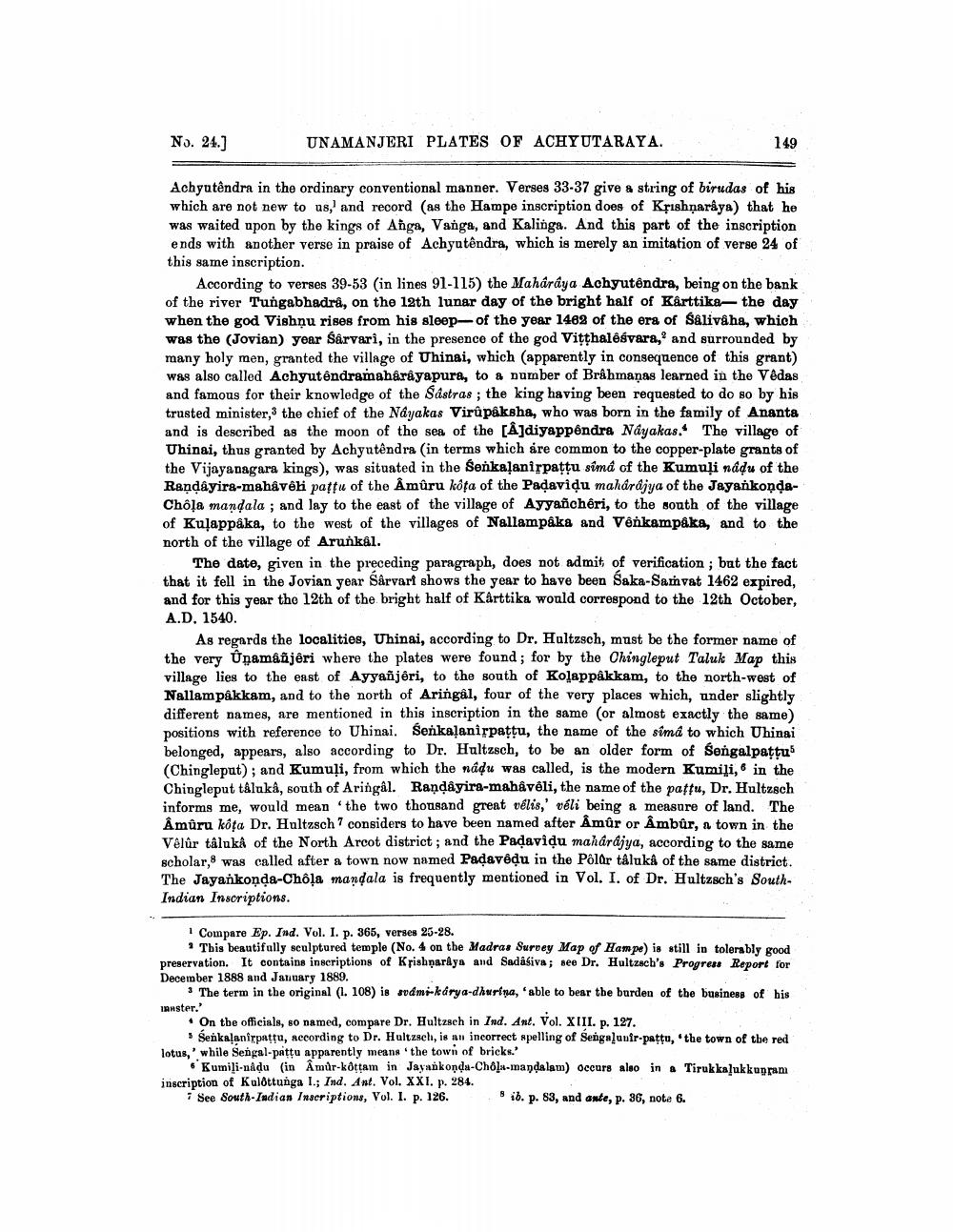________________
No. 24.7
UNAMANJERI PLATES OF ACHYUTARAYA.
149
Achyutêndra in the ordinary conventional manner. Verses 33-37 give a string of birudas of his which are not new to us, and record (as the Hampe inscription does of Krishnaraya) that he was waited upon by the kings of Anga, Vanga, and Kalinga. And this part of the inscription ends with another verse in praise of Achyutêndra, which is merely an imitation of verse 24 of this same inscription.
According to verses 39-53 (in lines 91-115) the Maharaya Achyutêndra, being on the bank of the river Tungabhadri, on the 12th lunar day of the bright half of Karttika- the day when the god Vishnu rises from his sleep- of the year 1462 of the era of Salivaha, which was the (Jovian) year Sårvari, in the presence of the god Vitthalêsvara, and surrounded by many holy men, granted the village of Uhinai, which (apparently in consequence of this grant) was also called Achyutêndramahåråyapura, to a number of Brahmaņas learned in the Vedas and famous for their knowledge of the Sastras ; the king having been requested to do so by his trusted minister, the chief of the Nayakas Virûpåksha, who was born in the family of Ananta and is described as the moon of the sea of the CÂ]diyappêndra Nayakas. The village of Uhinai, thus granted by Achyutêndra (in terms which are common to the copper-plate grants of the Vijayanagara kings), was situated in the Senkalanirpattu síma of the Kumuļi nadu of the Raņdayira-mahâveli pattu of the Amûru kota of the Padaviļu maharajya of the JayankondaChôļa mandala ; and lay to the east of the village of Ayyañchêri, to the south of the village of Kulappåka, to the west of the villages of Nallampaka and Venkampáka, and to the north of the village of Arunkál.
The date, given in the preceding paragraph, does not admit of verification, but the fact that it fell in the Jovian year Sårvart shows the year to have been Saka-Samvat 1462 expired, and for this year the 12th of the bright half of Kärttika would correspond to the 12th October, A.D. 1540
As regards the localities, Uhinai, according to Dr. Haltzsch, must be the former name of the very Únamañjêri where the plates were found; for by the Chingleput Taluk Map this village lies to the east of Ayyañjeri, to the south of Kolappakkam, to the north-west of Nallampakkam, and to the north of Aringal, four of the very places which, under slightly different names, are mentioned in this inscription in the same (or almost exactly the same) positions with reference to Uhinai. Senkalanirpattu, the name of the simá to which Uhinai belonged, appears, also according to Dr. Haltzsch, to be an older form of Sengalpattu (Chinglepat); and Kumuļi, from which the nádu was called, is the modern Kumili, in the Chingleput tåluka, south of Aringal. Randayira-mahåvéli, the name of the pattu, Dr. Hultzsch informs me, would mean the two thousand great vélis,' véli being a measure of land. The Âmûru kota Dr. Hultzsch 7 considers to have been named after Åmûr or Åmbûr, a town in the Vélûr tâlukå of the North Arcot district; and the Padavidu maharajya, according to the same scholar, was called after a town now named Padavôdu in the Polar tåluka of the same district. The Jayankoņda-Chôļa mandala is frequently mentioned in Vol. I. of Dr. Hultzsch's SouthIndian Inscriptions.
Compare Ep. Ind. Vol. I. p. 365, verses 25-28.
* This beautifully sculptured temple (No. 4 on the Madras Survey Map of Hampe) is still in tolerably good preservation. It contains inscriptions of Krishnaraya and Sadasiva; see Dr. Hultzach's Progress Report for December 1888 and January 1889.
* The term in the original (1. 108) is sodmi-karya-dhurina, "able to bear the burden of the business of his monster.'
On the officials, so named, compare Dr. Hultzsch in Ind. Ant. Vol. XIII. p. 127.
Senkalanirpattu, according to Dr. Hultzach, is an incorrect spelling of Sengaluuir-pattu, 'the town of the red lotus,' while Sengal-pattu apparently means the town of bricks.'
Kumili-nadu (in Amur-kőttam in Jayankonda-Chôļau-mandalam) occurs also in a Tirukkalukkugram inscription of Kulottunga I.; Ind. Ant. Vol. XXI. p. 284. See South Indian Inscriptions, Vol. I. p. 126.
ib. p. 83, and ante, p. 36, note 6.




